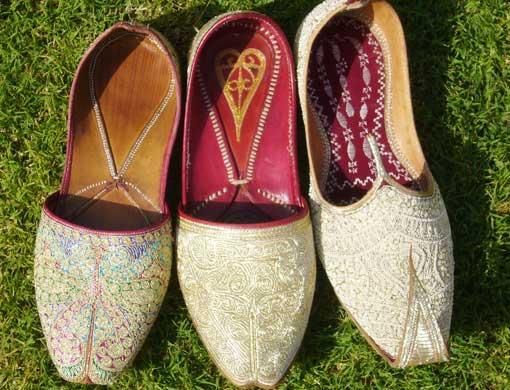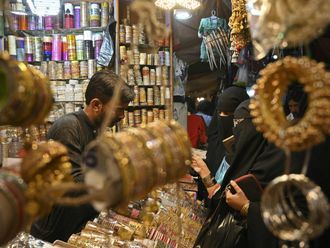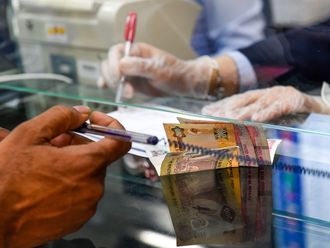The khussa has its roots in the region's history and is part of its rich cultural heritage.
Every country has its characteristic footwear that has evolved over centuries to suit the climate of the region, and Pakistan is no exception. However, the country has different environmental zones — from stark deserts to the tallest mountain ranges in the world. Hence the warmer shoes worn in the northern parts of the country are different from their more open sandal-like footwear in the south.
Great variety
At gift shops you can also pick up miniature khussas or chappals for gifts or in the form of key chains. The Peshawari chappal is worn in the northern areas where the weather is colder. This is why the leather used is thicker — these can be plain or embroidered. Women wear very brightly coloured shoes usually with tiny pompoms attached on top of the shoe at the front. There are variations on this which are used in warmer climes and then there is the Kohlapuri which is still worn in many parts of the subcontinent. It is ideal for warm weather because it is an open sandal. The variations in this are also endless in terms of shape and colour.
One of the traditional types of footwear worn in Pakistan, the khussa has its roots in the region's history and as such is part of a rich cultural heritage. Initially in the central and southern parts of the country flat wooden slippers were worn — a tradition probably acquired from China. However these slippers were not very efficient in protecting the foot from both dirt and cold weather.
Over time the material was replaced — wood was hefty and heavy whereas in an agrarian society not only was leather easily available but also light and soft. The Lahore Museum showcases in its Islamic Gallery archaic khussas which are hand-crafted leather shoes. Although in use by the rural population for centuries, the khussa arrived in the palaces of the Mughal Empire much later and it was then that its history started to be recorded. The rural word khussa was replaced by the more eloquent Saleem Shahi. Saleem was also the nickname of the Mughal Emperor Jehangir (17th century AD).
There are some visible differences between these two varieties of shoe. The Saleem Shahi has a generally finer shape and is usually decorated with very intricate hand-embroidered patterns in gold (or multi-coloured) thread — fit for the royal court.
The Mughal emperors were not the only rulers in the subcontinent who adopted the khussa. They also adapted the shape and thus different ‘cousins' of the original shoe were born. The most interesting part of the shoe is its curly tip. The left and right are not cut in different shapes as is the case with modern shoes — they can be interchanged.
The famous Sikh leaders Ranjeet and Sher Singh are depicted in miniature paintings wearing khussas. The Sikh society generally preferred a type of khussa known as ‘Jodhpuri'. Hoshiarpur, a district in the province of Punjab also lent its name to a delicate version usually worn by women which tended to be finer in shape, with finer embroidery and with a lower cut top which only covered the toes.
The Miscellaneous Gallery in the Lahore Museum also displays portraits of Chinese visitors wearing shoes that are similar to khussas. Even amongst the younger generation of Pakistanis the khussa is recognised as a valuable cultural gift. The various types: Desi Jutta, Saleem Shahi and Nagra khussa all make wonderful, useful gifts. Although very similar in shape, it is the particular patterns and type of leather that give the shoes their identity.
The Saleem Shahi, for instance, tends to be made of goat skin whilst the Nagra is usually made of camel skin. The type of leather determines the weight, texture and durability of the shoe. In modern times, most people are not aware of the differences, and the names used for these shoes are often used interchangeably – for instance the Saleem Shahi is also known as TalaKangi, Chakwali, Multani, Bahawalpuri, Qasoori, Sharakpuri,Waziraabadi, Multani Phool wala, Khussa slipper and so on. These names usually depict the place of manufacture.
Multani khussa
It is said that the khussas of Multan are the most beautiful and best made. The main industry resides in the cobbled streets of ancient Multan and the shoes are supplied nationwide. When you browse the glass displays you can see khussas that have fine tilla work (gold thread embroidery), sequins (sitara) and beads (moti) work. You will also spot the Waziraabadi khussa which has an upper part that is created skillfully out of cut-work. Delicate patterns are made that create a filigree effect. Then there is is the Shurkrpuri khussa which is embroidered with white tilla (metallic thread) on red, black and skin-colored leather. Multani Phool wala and khussa slippers (which have no backs) are made specifically for women.
Inside the shops the khussas are stacked neatly depending on the type and size. As these shoes are made of natural material they tend to adopt to the shape of the foot quite easily. The only trouble is that sizes are not standardised. The best way to find the right size is, of course, to try them on but if you want someone to pick you a pair you must draw a footprint and send it with the buyer.
Most khussas are very popular in rural villages where cobblers make the shoes on order for the peasants and farmers. Most of central Pakistan is agrarian and the farmers are aware of the comfort and durability of these shoes made from pure leather so they are the preferred footwear.
Handmade magic
Unlike modern shoes which are usually machine-made, at least in some part, the khussa is made entirely by hand from the curing of the leather to the cutting and sewing together of the insole, outsole, sole and vamp. The embroidery can be very intricate or the decorative element may be as simple as raised leather lines on the upper sole. Khussas traditionally have no heel — they are completely flat and tend to be very comfortable. Having said that, more modern versions have begun to accommodate changing fashion trends — beaded khussas' with small heels. These are often worn by women as formal evening wear and are available in a huge variety of styles and colours — embroidered, sequined, lower cut soles, very high soles, turned up toes, square shaped fronts — the combinations are endless.
Due to continuing demand, craftsmen have kept their profession alive. Some say the tradition of using leather for shoes was founded in this region after it was invaded by Alexander the Great. There are craftsmen who have been making khussas for decades and the tradition looks like it will continue.
This is particularly so with the revival of traditional South Asian footwear on couture catwalks and as part of high street fashion where you will often glimpse variations of embroidered and embellished khussas, mules and chappals. This khussa can still be found in its original shape and so wearing these traditional shoes truly is like wearing a bit of history.













